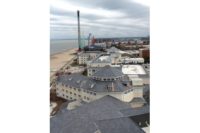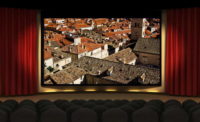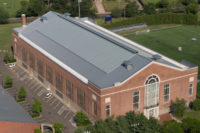Between April and October 2013, the iconic Cobo Center in downtown Detroit — a massive convention and exhibition center that’s home to the North American International Auto Show — underwent a 200,000-square-foot roof replacement as part of a $229 million renovation. This was a far cry from the average commercial roofing project, and it required just the right contractor and materials to get the job done.
The re-roof was awarded to Schreiber Corporation. Founded in Detroit in 1916, the privately owned company specializes in commercial, industrial and automotive roofing projects throughout the United States and Canada. “We competitively bid this project against other local contractors and were fortunate enough to have the best price going in,” Senior Project Manager Rich Gagnon explained. “It was an advertised project, and we were fortunate to have been included in the invitation process.”
Schreiber has long-time ties to Detroit and has done many significant projects related to the automotive industry throughout the years, making the company a perfect match for the Cobo job. “About 75 percent of our work is automotive related; we primarily serve The Big Three. Some of our recent projects include Ford plants in Dearborn, Mich.; Nashville, Tenn.; and Kansas City, Mo.; along with the Chrysler Technical Center building and a GM Assembly Plant in Arlington, Texas. We have just begun operations at the new Oakland University Engineering Center in Rochester, Mich.”
According to Gagnon, the large-scale Cobo project presented its own unique set of challenges. “This project was a major undertaking,” he explained. “We had to accomplish it in a limited time frame, which meant we needed 25 guys on the roof for four months. There was limited access, so we had to drive the materials to the top of the parking structure using the existing automobile ramp, which proved to be challenging. The contract called for the removal of the existing BUR roof that was originally put on by Schreiber more than 20 years ago. One significant aspect of this undertaking was to keep the new, white roofing membrane looking new, knowing the roofing removal process generates a large amount of dirt and airborne dust; the crew did a great job. We are especially proud of our sheet metal crew, as they were able to completely reconstruct the bases of the air houses and come up with some creative ways to uniquely integrate the expansion joint covers to blend with some widely varying conditions.”
Once these uncommon obstacles were addressed, the Schreiber team installed the new roof system. “This was a fully adhered membrane TPO project,” Gagnon explained. “We started off by mechanically attaching a layer of 5/8-inch thick DensDeck Prime, followed by a self-adhered vapor retarder, after which two layers of 2½-inch polyisocyanurate insulation and a 5/8-inch DensDeck Prime cover board were adhered in low-rise foam adhesive. The 80 mil Firestone TPO membrane was fully adhered.”
“We did the largest application of Firestone UltraFlash on record: 8,000 square feet,” Gagnon continued. “The coating has an activator, and we had only 25 minutes to use a whole pail before it cured. Since this was our first effort with this material, there was a certain learning curve, and thankfully the owner is pleased with the results.”
The roof installers also enjoyed working with the recently enhanced cover boards. “The foreman came up to me and thanked me for ordering the different DensDeck Prime. He said it scored and snapped better, was smoother, took less adhesive and the sheets laid down tighter,” Gagnon said. “When you’ve got a product that the architects specify, the owners appreciate and the installers rave about, it’s a winner all around.”
Overall, Gagnon was more than satisfied with how the Cobo re-roof turned out. “This was a unique job in which our foreman took it on as being a personal challenge. It was a concise and dedicated effort of which he is definitely proud,” he said. “We had quite a number of carpentry situations to work out. We had to rebuild some of the walls and re-establish details to make things fit. Many of the original design details were modified by the manufacturer so as to ensure the 30-year warranty could be issued. The support from the owner and their subcontractor, Jenkins Construction — specifically David Bate — really helped us out. Their continuous support in facilitating the work was instrumental, and I don’t know how it could have gone any better. It was quite a relief to know the North American Auto Show could take place on schedule!”







Report Abusive Comment